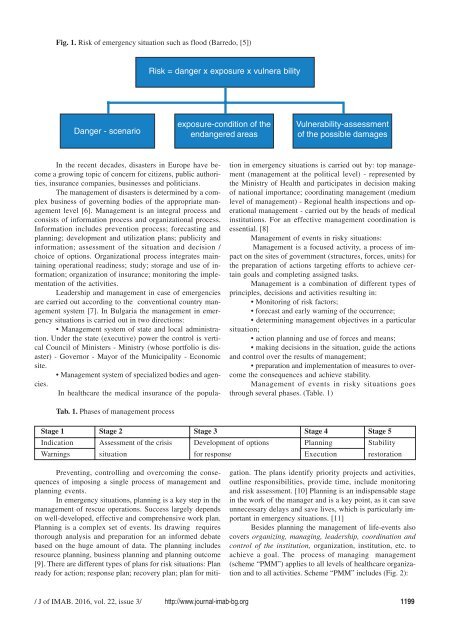JofIMAB-2016-vol22-issue3
You also want an ePaper? Increase the reach of your titles
YUMPU automatically turns print PDFs into web optimized ePapers that Google loves.
Fig. 1. Risk of emergency situation such as flood (Barredo, [5])<br />
Risk = danger x exposure x vulnera bility<br />
Danger - scenario<br />
exposure-condition of the<br />
endangered areas<br />
Vulnerability-assessment<br />
of the possible damages<br />
In the recent decades, disasters in Europe have become<br />
a growing topic of concern for citizens, public authorities,<br />
insurance companies, businesses and politicians.<br />
The management of disasters is determined by a complex<br />
business of governing bodies of the appropriate management<br />
level [6]. Management is an integral process and<br />
consists of information process and organizational process.<br />
Information includes prevention process; forecasting and<br />
planning; development and utilization plans; publicity and<br />
information; assessment of the situation and decision /<br />
choice of options. Organizational process integrates maintaining<br />
operational readiness; study; storage and use of information;<br />
organization of insurance; monitoring the implementation<br />
of the activities.<br />
Leadership and management in case of emergencies<br />
are carried out according to the conventional country management<br />
system [7]. In Bulgaria the management in emergency<br />
situations is carried out in two directions:<br />
• Management system of state and local administration.<br />
Under the state (executive) power the control is vertical<br />
Council of Ministers - Ministry (whose portfolio is disaster)<br />
- Governor - Mayor of the Municipality - Economic<br />
site.<br />
• Management system of specialized bodies and agencies.<br />
In healthcare the medical insurance of the population<br />
in emergency situations is carried out by: top management<br />
(management at the political level) - represented by<br />
the Ministry of Health and participates in decision making<br />
of national importance; coordinating management (medium<br />
level of management) - Regional health inspections and operational<br />
management - carried out by the heads of medical<br />
institutions. For an effective management coordination is<br />
essential. [8]<br />
Management of events in risky situations:<br />
Management is a focused activity, a process of impact<br />
on the sites of government (structures, forces, units) for<br />
the preparation of actions targeting efforts to achieve certain<br />
goals and completing assigned tasks.<br />
Management is a combination of different types of<br />
principles, decisions and activities resulting in:<br />
• Monitoring of risk factors;<br />
• forecast and early warning of the occurrence;<br />
• determining management objectives in a particular<br />
situation;<br />
• action planning and use of forces and means;<br />
• making decisions in the situation, guide the actions<br />
and control over the results of management;<br />
• preparation and implementation of measures to overcome<br />
the consequences and achieve stability.<br />
Management of events in risky situations goes<br />
through several phases. (Table. 1)<br />
Tab. 1. Phases of management process<br />
Stage 1 Stage 2 Stage 3 Stage 4 Stage 5<br />
Indication Assessment of the crisis Development of options Planning Stability<br />
Warnings situation for response Execution restoration<br />
Preventing, controlling and overcoming the consequences<br />
of imposing a single process of management and<br />
planning events.<br />
In emergency situations, planning is a key step in the<br />
management of rescue operations. Success largely depends<br />
on well-developed, effective and comprehensive work plan.<br />
Planning is a complex set of events. Its drawing requires<br />
thorough analysis and preparation for an informed debate<br />
based on the huge amount of data. The planning includes<br />
resource planning, business planning and planning outcome<br />
[9]. There are different types of plans for risk situations: Plan<br />
ready for action; response plan; recovery plan; plan for mitigation.<br />
The plans identify priority projects and activities,<br />
outline responsibilities, provide time, include monitoring<br />
and risk assessment. [10] Planning is an indispensable stage<br />
in the work of the manager and is a key point, as it can save<br />
unnecessary delays and save lives, which is particularly important<br />
in emergency situations. [11]<br />
Besides planning the management of life-events also<br />
covers organizing, managing, leadership, coordination and<br />
control of the institution, organization, institution, etc. to<br />
achieve a goal. The process of managing management<br />
(scheme “PMM”) applies to all levels of healthcare organization<br />
and to all activities. Scheme “PMM” includes (Fig. 2):<br />
/ J of IMAB. <strong>2016</strong>, vol. 22, issue 3/ http://www.journal-imab-bg.org 1199



